Skip the trial and error: I’ve tested these fish finders on the ice so that you don’t waste money on gear that can’t handle the cold. Find your ideal match below.
Last updated: December 9th, 2025
- Best Overall: Humminbird Ice Helix
- Budget Option: Garmin Striker Plus 4 with Portable Kit
- Best Flasher: Humminbird ICE-55 Six-Color Flasher
- Premium Option: Garmin ECHOMAP UHD2 93sv LiveScope Ice Fishing Bundle
- Recent Updates
- Testing Procedure
- How to Choose the Best Ice Fishing Fish Finder
- Conclusion
- Frequently Asked Questions
Here’s a quick overview of our top picks:
| Product | Anglers Rating | Sonar Type | Price | Shop At |
|---|---|---|---|---|
| Best Overall Humminbird Ice Helix 5 Portable & Versatile | Dual Spectrum CHIRP Exc. Target Separation | $$ | FishUSA | |
| Budget Option Garmin Striker Plus 4 With Portable Kit | Dual Beam CHIRP Standard Flasher | $ | Cabela’s | |
| Premium Pick Garmin ECHOMAP UHD2 LiveScope Ice Bundle | LiveScope™ Real-time Scanning | $$$$ | Bass Pro |
Best Overall: Humminbird Ice Helix
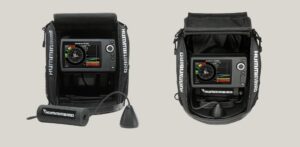
Specs
Pros
Cons
Why I Chose It
I’ve spent countless hours on the ice with different fish finders, and the Ice Helix 5 has become my go-to unit for its reliability and impressive feature set. The 5-inch screen might not be the biggest, but for the price, you can’t go wrong.
If the screen size is a deal-breaker for you, the all-season unit comes in a 7- and 9-inch size as well. The Humminbird Ice Helix 7 is about $600 more, though, which is more than double the cost.
To upgrade to a 9-inch screen with the Ice Helix 9, look to spend nearly $3,000. For a few inches of screen, I don’t see the need to spend that kind of money on a unit that has all the same features.
The Ice Helix stands out as an ideal choice for both weekend warriors and serious ice anglers who want professional-grade performance without having to shell out thousands like you would for the Garmin Panoptix LiveScope.
What I love most is its adaptability — you can use it on your boat in summer and then quickly convert it for ice fishing in winter.
The sonar customization really impressed me during testing. You can fine-tune the gain, chart speed, and interference rejection to match your fishing conditions.
I typically run my chart speed at 3 or 4 out of 10, which gives me the perfect balance between real-time feedback and useful sonar history.
Battery life used to be an issue with the standard sealed lead acid battery, but switching to a lithium battery increased the runtime. Now I can fish for two full days on a single charge even if I’m running other accessories in the background.
Transportation is simple with the carrying case, and you’re good to start using it straight out of the box because it comes with everything you need.
If you’re in the market for a reliable ice fishing system that won’t let you down when the bite gets hot, the Ice Helix deserves more than your consideration.
Budget Option: Garmin Striker Plus 4 with Portable Kit

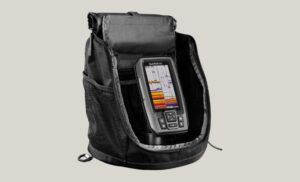
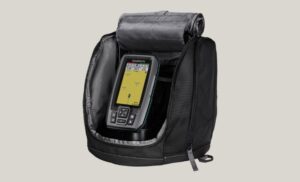

Specs
Pros
Cons
Why I Chose It
I don’t know about you, but we’re not all made of money. If I’m going to spend money on a fish finder, I want one that will work all year, like the Garmin Striker Plus 4. It’s simple, reliable, and durable.
This perfectly priced ice fishing sonar unit has Dual Beam CHIRP, which has an excellent target separation of 1”. This makes it easier to be sure your fish finder has actually found a fish and not something else, but the cold water does decrease the accuracy a tad.
Portability is important with all fish finders but ice fishing ones especially. The Striker’s small size and carrying case, which doubles as protection, mean you won’t be making multiple trips from your car in the freezing cold.
I also like that you don’t have to put this away during the summer. Just purchase an open-water transducer and easily switch it out.
Though there’s a lot to love about this unit, there are also some cons.
The lower price means it also has fewer premium features, like LiveScope or multiple viewing angles like you’d get in the Garmin ECHOMAP. You just can’t expect to get the latest and greatest sonar technology for under $500.
If you wear glasses like I do, the 4-inch screen, another budget feature, can be difficult to read.
If you’re a beginner, though, these few cons shouldn’t stop you from buying the Garmin Striker Plus 4 Ice Fishing Bundle.
It’s an excellent fish finder to learn on, and you can always upgrade later after you understand how to read a depth finder or flasher. For the features it has, it’s tough to beat this price. Grab one today!
If you’d like to learn more about it, give our complete Garmin Striker 4 review a read.
Best Flasher: Humminbird ICE-55 Six-Color Flasher
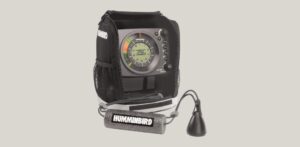
Specs
Pros
Cons
Why I Chose It
Ice fishing is not for the faint of heart; neither is the Humminbird ICE-55 Flasher. It’s designed to function at temperatures as cold as -20 degrees, which means you can rely on it to inform you of fish in nearly any fishable condition for years to come.
This is one tough machine.
It’s also very portable, thanks to the carrying case that holds and protects the transducer, battery, and flasher.
In all fairness, the Humminbird ICE-55 ice fishing flasher has some downsides you should be aware of too.
The small display means you’ll need to keep it close by to read the LCD screen, which isn’t a huge problem, especially in an ice shanty.
The other thing I’m not crazy about is the sensitivity of the transducer. It will pick up small jigs near the surface, but as you fish deeper water, you’ll have a tougher time. If you fish 10’–20’ of water, this isn’t such a big deal, but when you begin to fish 20’+, it gets frustrating.
Even with the drawbacks, the Humminbird ICE-55 Flasher series is for the serious ice-fishing angler. If you choose to fish in the most extreme of conditions, you’ll need gear that holds up.
Premium Option: Garmin ECHOMAP UHD2 93sv LiveScope Ice Fishing Bundle

Specs
Pros
Cons
Why I Chose It
This is the ultimate premium ice fishing system for serious anglers who demand the absolute best in sonar technology.
What sets the LiveScope Plus bundle apart is its ability to deliver crystal-clear, real-time views of fish and structure — it’s like having an underwater video camera that can see in every direction.
The unit’s dual-viewing modes are game-changing on the ice. Down view lets you watch fish react to your bait in real-time, while forward view helps you spot schools of fish up to 200 feet away.
I’ve used this to plan my next holes without drilling unnecessary ones, making my time on the ice much more efficient.
Remember, since we’re talking about ice fishing, there’s a lot more value in being able to plan your holes ahead of time without having to drill and insert anything into the ice.
If you’re a dedicated ice angler who fishes tournaments or spends serious time on the ice, the ECHOMAP UHD2 93sv LiveScope bundle is worth every penny. Yes, it’s a significant investment at over $3,000, but hey, you might never have to buy another fish finder again!
Recent Updates
- Nov 22, 2024: Removed the Deeper CHIRP 2 Wi-Fi as the best portable option because I believe the Garmin Striker 4 Portable Bundle is more effective.
- Nov 19, 2024: Replaced the Garmin Panoptix LiveScope with the ECHOMAP UHD2 LiveScope bundle as our premium pick because it better represents current technology and the latest advancements in live and interactive sonar. In doing this, I also made the Humminbird Ice Helix 5 our best overall choice because of a more moderate price point.
Testing Procedure
Below you’ll find a quick rundown of what I looked for when testing and ranking the fish finders in this article.
User-friendliness: While testing these units, I wanted to know how easy they were to operate. I like to keep things as simple as possible. If it’s complicated or not user-friendly, I’m much less likely to use it.
Price: Budget is something we all must keep in mind when buying anything, but especially gear for our favorite hobby. While researching and testing the products, I kept the price versus the number of features in mind.
My “Best Overall” pick is always the best option for the average angler, not a tournament angler. Sure, the Garmin LiveScope ice fishing bundle is the best if you have $3,000, but most of us recreational anglers aren’t trying to spend that kind of money.
Durability: Fishing is tough on equipment. Now add below-freezing temps on top of already tough conditions, and you have a recipe for broken or malfunctioning equipment. The units above will be able to handle the harshest of environments.
Portability: When ice fishing, it’s important to stay mobile. Owning an easily transportable fish finder makes all the difference in the world when you’re lugging it in your sled or carrying it by hand to your next hole. During my tests, I ensured they were easy to carry.
How to Choose the Best Ice Fishing Fish Finder
Frequency
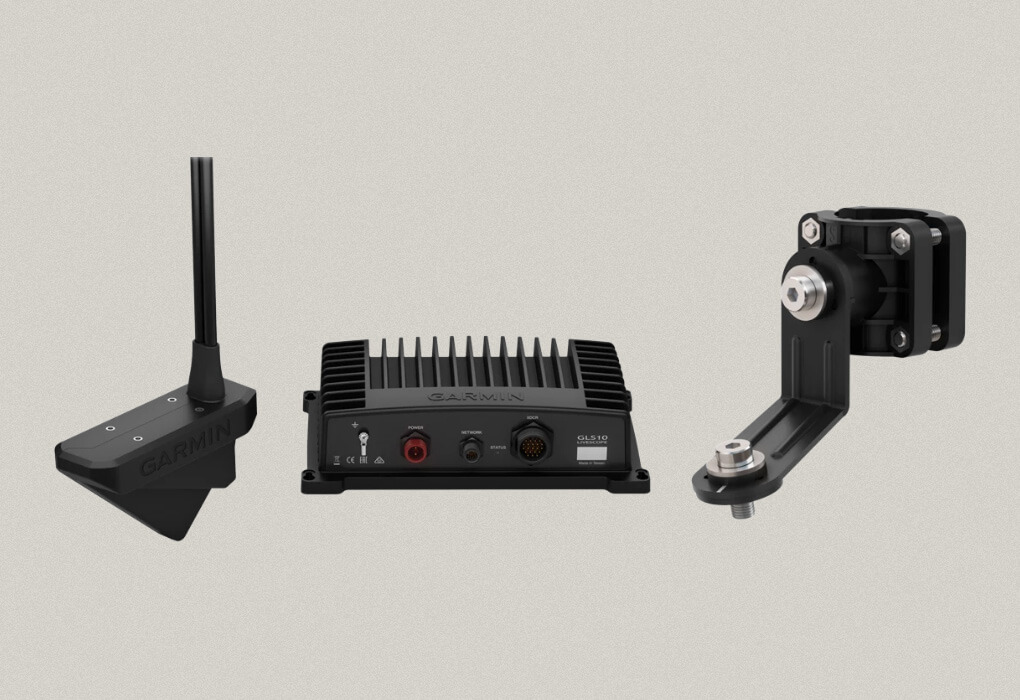
Fish finders with high frequencies work best in shallow water, while low frequencies are better in deeper water. This isn’t as important as knowing what kind of frequency your unit has.
Some have single frequencies, while others have dual frequencies. Going for a dual-frequency fish finder allows you more flexibility over where you use the device because you’ll be able to adjust the settings for the situation.
For example, if you frequently fish in different locations, you’ll want a unit that’s flexible enough so you can customize the settings based on the individual scenario.
If you have a single-frequency unit, you’re limited to fishing one particular depth.
Method of Imaging
The method of imaging depends on the type of transducer you have. Many of these units use Chirp sonar. This means the fish finder is sending sonar down into the water on a continuous “chirping” basis, and that’s what is providing you with the images.
You’ll also hear terms like DownVu, SideVu, sidescan, downscan, and other similar phrases. These refer to sonar that goes directly down vertically or horizontally away from you in all directions.
These are all important for a few reasons.
First, with ice fishing, you can’t adjust your location by simply moving your boat a few hundred feet in another direction. So, having a side-scanning finder is nice, but these are harder to come by, and they’re not as popular with ice fishing because the technology hasn’t been developed yet.
Down scanning is much more popular, and it gives you a picture of everything that is happening beneath you at a certain radius.
For most ice anglers, this will do the trick. Most CHIRP sonar functions like this as well.
Beyond the transducer, how the fish finder interprets the sonar into the image on the screen is also important. Some use fishID technology, which is the easiest to read. It’ll show you arcs of variable sizes on the screen, and that will tell you where the fish are located and where you might run into some structure.
Other ice fish finders use a color-based technology that will simply offer a red, yellow, or green color telling you whether or not you should fish here. This is useful prior to drilling because you’ll be able to identify ideal locations before drilling the hole.
If you don’t have an ice transducer, you’ll have to wait until after the hole is drilled so you can get the transducer into the water.
Power Source
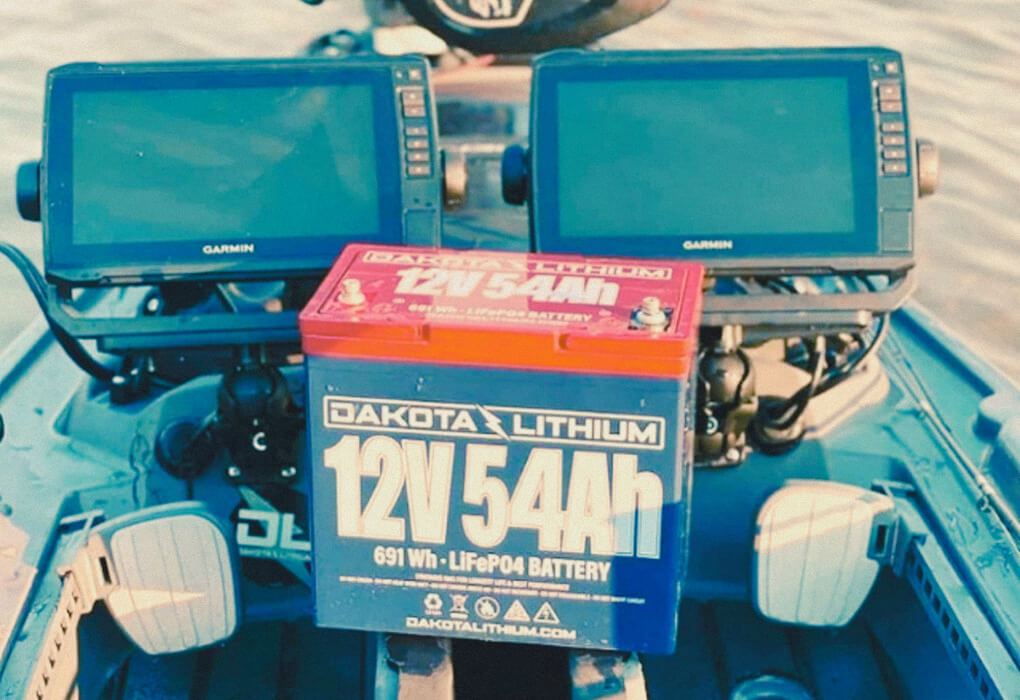
Power translates into speed. If you have a high-powered fish finder, you’ll get a faster image, so you won’t have to wait around as long. The downside is they use more power, which can drain batteries faster and require more charges.
When you’re out on the ice, I doubt you have a ton of readily available power sources, so you’ll want to make sure you understand how long the fish finder will operate, how many uses you get, what drains it, what sustains it, and so on.
Display
You need a high-resolution screen for a few reasons. First, you need to be able to read it to tell what’s going on under the ice. If your screen is hard to read, has a heavy glare, or is challenging to operate, it won’t help you that much.
Keep the type of display in mind as well. You’ll notice that some ice-fishing fish finders have unique displays that are different from what you’ll see on boats. That’s because they read the water through the ice, so they don’t provide an elaborate picture of everything going on, but a simple yes (fish here) or no (don’t fish here).
These are much better for use as ice fishing locators, but they can take some getting used to if you’ve never used one before.
Lastly, what does the screen tell you? Some fish finders have built-in depth finders that provide information such as total water depth, temperature, and more. These are all valuable pieces of information, and you should factor in how much you get for your money before pulling out your wallet.
Most decent fish finders will offer a lot of on-screen information.
Portability

Portability is a huge factor in ice fishing, and I’ll tell you why. You never know how far you’ll be from the spot. It could be a few feet or as long as a mile or two.
When you have to walk that long on a nice, balmy summer morning, no big deal. When you have to walk that long in the middle of January with the frigid wind blowing around you, big deal.
You definitely don’t need more ice fishing gear to carry, and having an easily portable fish finder for ice fishing is always the way to go.
Most of the options recommended above are portable, and if they’re not, they come with carrying cases. Just make sure the carrying case is waterproof.
Multipurpose Use
Ideally, you want to get a unit you can use all year. Many of the options available on Amazon work for both cold and warm water, except the ones with the dedicated ice fishing transducer.
Those are for hardcore ice anglers who go out multiple times per week for ice jigging. If that sounds like you, go for it; get yourself the best ice-fishing fish finder money can buy.
If you’re someone more like me, who likes ice fishing and goes a few times a year but still would rather have a versatile fish finder that’s usable in the summer, then you’ll want to apply a different philosophy.
Keep in mind that you can buy an ice fishing transducer for almost any fish finder. So, it might be beneficial to get a standard fish finder and try to fit it for ice fishing.
Just keep in mind how that may impact the accuracy of the device.
Ease of Use

Ease of use is always a factor, especially because everyone isn’t up-to-date on the latest technology, and they continue to make things more complicated.
Using a fish finder shouldn’t be difficult, and it’s not, but that’s why I prefer to shop from major brands. By shopping Garmin, Humminbird, Lowrance, and some of the other major companies, you know you’re getting a product with clear instructions and likely backed up by decent customer service and an equally decent warranty.
Setting up your fish finder shouldn’t take longer than a few minutes, and learning how to operate it should happen as you go.
We’ve also written articles that can help you learn how to read a fish finder if that’s where you get tripped up.
Conclusion
For most anglers, the Humminbird Ice Helix 5 hits the sweet spot of performance and value. Its Dual Spectrum CHIRP sonar delivers outstanding target separation, and the ability to use it year-round makes it an incredible value. If you’re looking for the best overall combination of features, performance, and price n ice fishing electronics, this is your unit.
Anglers just getting started or fishing on a budget should check out the Garmin Striker 4. While it may lack some premium features, it offers reliable performance and basic GPS functionality at a price point that won’t break the bank.
For serious ice anglers who demand the absolute best, the Garmin ECHOMAP UHD2 93sv LiveScope bundle is worth the investment. Its real-time sonar imaging is simply incredible — it’s like having an underwater video camera showing you exactly where the fish are.
If you have any additional questions or need help, drop a comment below and I’ll get back to you ASAP.
I monitor and reply to each comment that comes in!
Frequently Asked Questions
What’s the difference between an ice fish finder and a regular one?
The difference between an ice fish finder and a regular one is that the transducer is built to withstand cold temperatures.
The transducers are also much different because ice fishing transducers can actually provide readings right through the ice. You don’t necessarily need one that can do that, but they’re convenient.
Does the ice fish finder need to be waterproof?
Yes, the ice fish finder needs to be waterproof. This will help keep water from ruining your unit.
Can I use any fish finder for ice fishing?
Yes, you can use any fish finder for ice fishing, but the cold temperature ruins the transducer on a lot of cheap fish finders because they’re not designed for extremely cold temperatures. It’s best to use a fish finder designed for ice fishing.

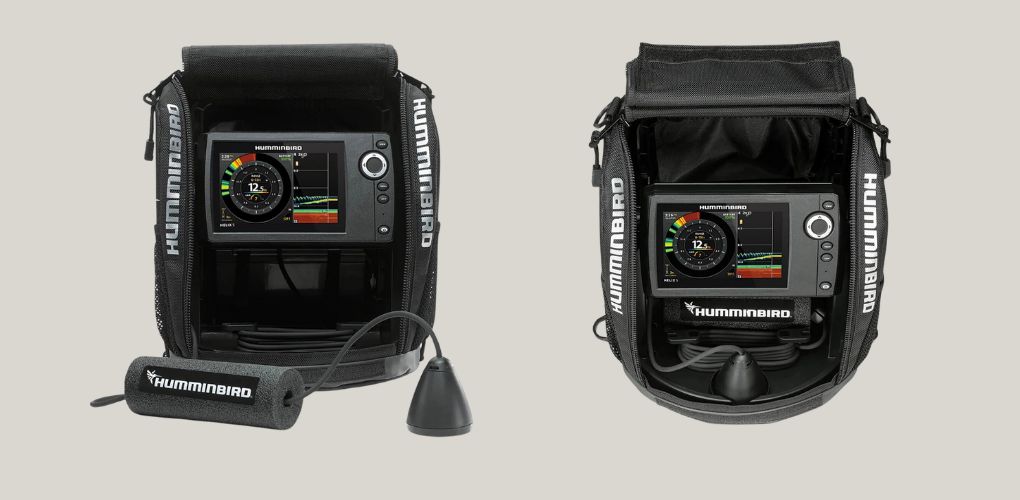
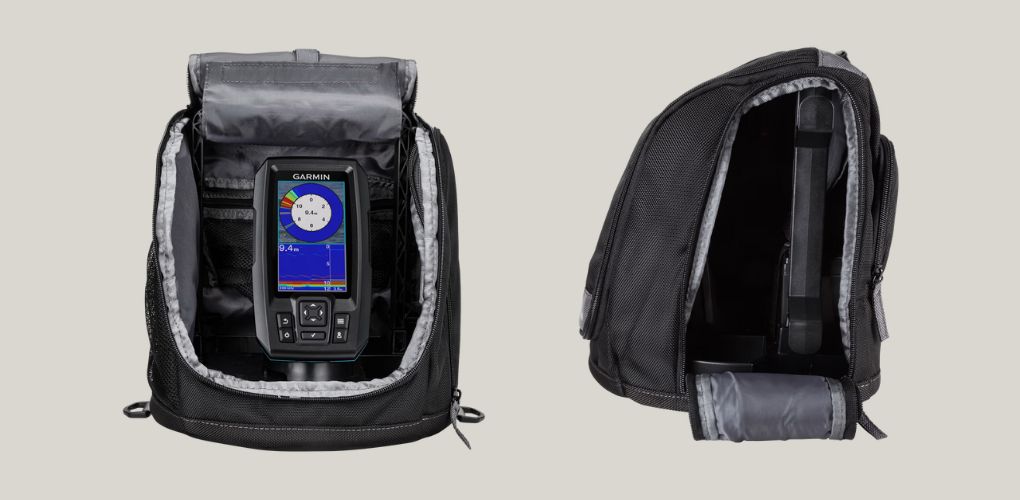





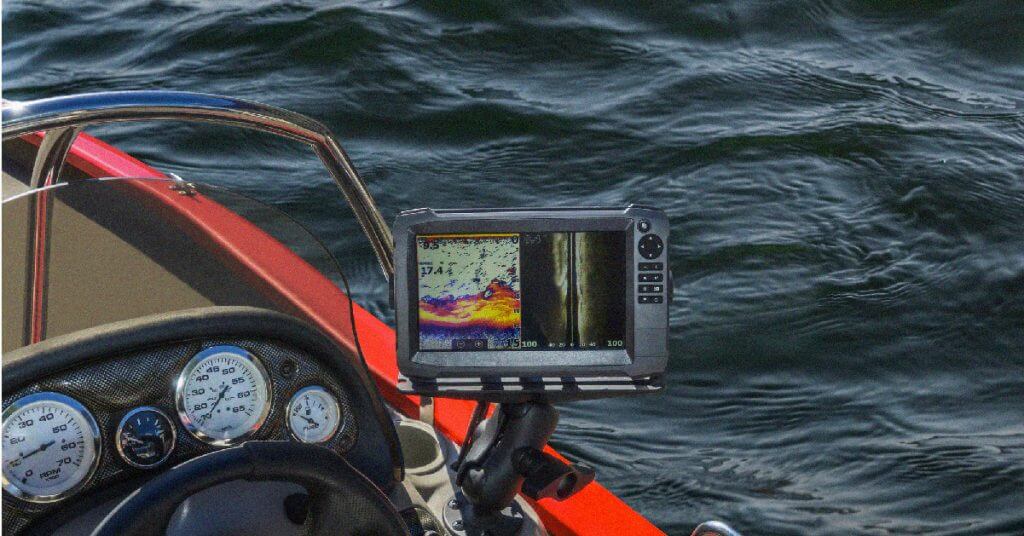

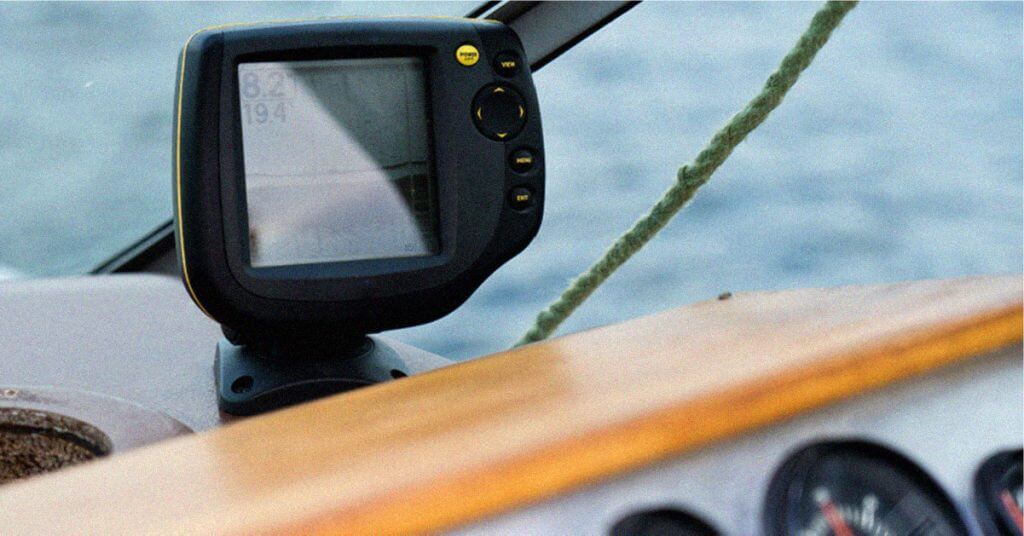

Nothing about price, therefore useless. If it’s the best fish finder in the world and costs $1700, I don’t care and I don’t want to read 43 pages to find out … I don’t care.
We will never include prices in our reviews because they fluctuate and change from week to week. To find the price, all you need to do is click the button and it takes you right to the Cabelas page to see that the price of the top pick is only $350. If that’s too much effort for you, feel free to read some of the other top ice fish finder reviews but you’ll disappointed when you realize that none of them include pricing for the same reason.